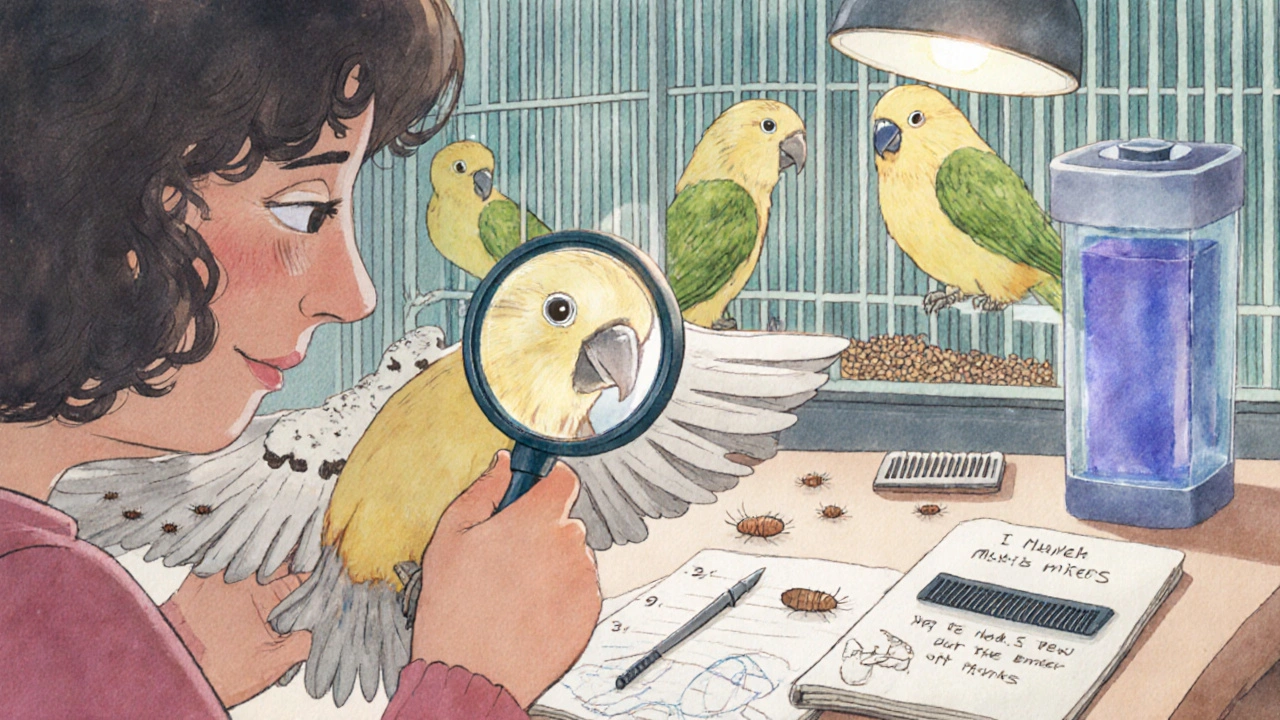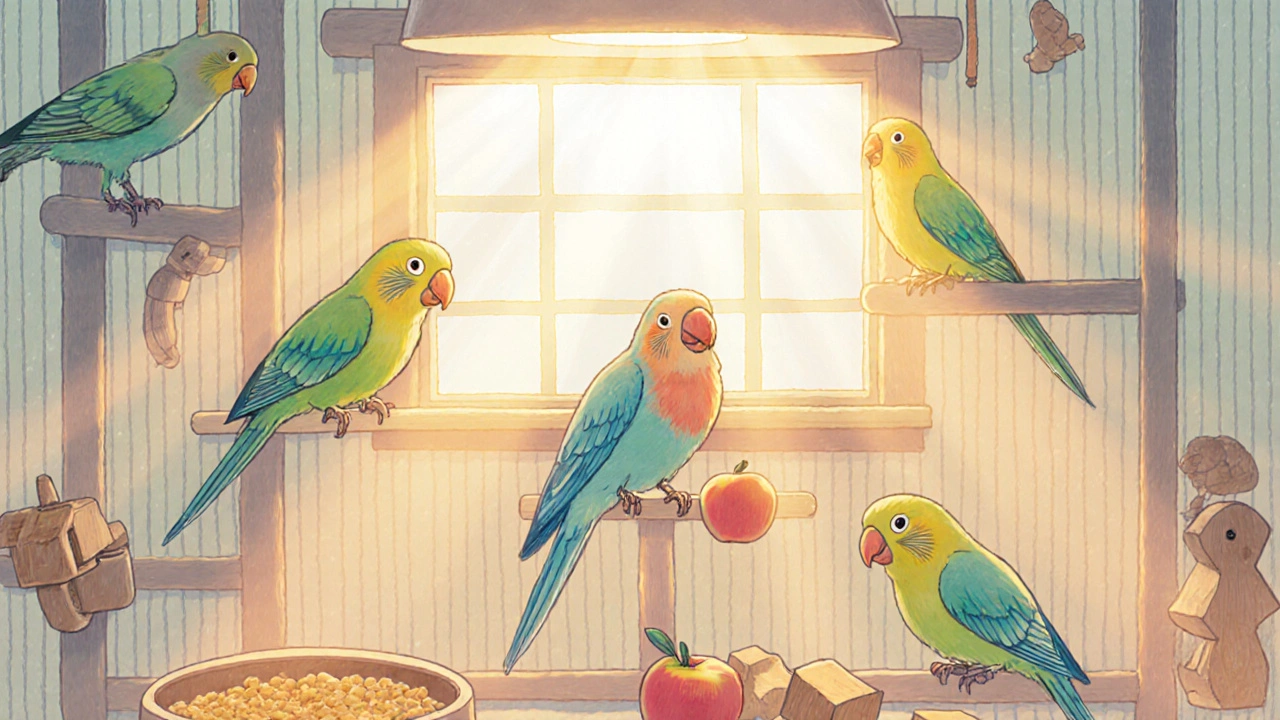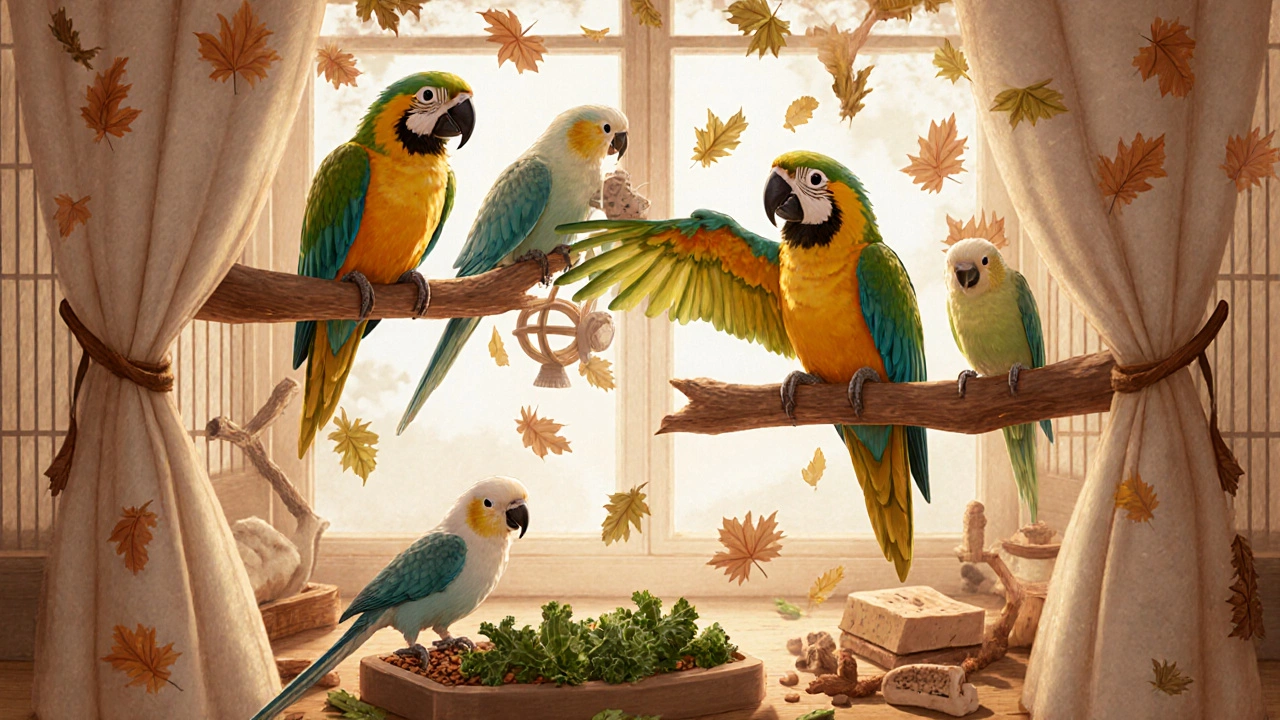Feathers falling out in one bird might be normal during molting-but when multiple birds in the same cage or aviary start losing feathers, it’s not just a seasonal thing. Deplumation isn’t a disease itself, but a symptom of something deeper going on. If you’ve got three parrots, two budgies, and a cockatiel all sharing space, and suddenly you’re sweeping up feathers like it’s autumn, you’re not imagining it. Something’s off. And if you ignore it, it can turn into serious health issues-or worse, aggression that leads to injury.
What Causes Deplumation in Multi-Bird Households?
Deplumation doesn’t happen for no reason. In a group setting, the causes pile up fast. The most common ones? Stress, poor nutrition, parasites, and social conflict.
Stress is the silent killer here. Birds are prey animals. They don’t handle change well. A new bird added to the group? A moved cage? A loud vacuum cleaner? Even a change in your work schedule can throw them off. When stressed, birds start plucking-not just themselves, but others too. You’ll see bare patches on the chest, wings, or back, sometimes with broken feather shafts still sticking out.
Then there’s nutrition. A seed-only diet is a recipe for disaster. Birds need variety: pellets, fresh veggies, fruits, nuts, even cooked grains. A lack of protein, vitamin A, or calcium weakens feathers and makes birds more likely to pick at their own or others’ plumage. I’ve seen cockatiels with feather loss because they weren’t getting enough dark leafy greens or calcium blocks.
Parasites like mites or lice don’t always show up on the surface, but they itch. And when one bird is itchy, others notice. They start preening the itchy bird-and sometimes, they don’t stop. That’s when it turns from grooming into feather destruction.
And then there’s the social side. Birds have hierarchies. One bird might be the boss. Another might be the scapegoat. In tight spaces, the lower-ranking bird gets picked on constantly. Feather plucking becomes a way to assert dominance-or a way to cope with being bullied. You might see one bird constantly chasing another away from perches, or sitting too close, pecking at feathers during quiet moments.
How to Tell If It’s Stress, Illness, or Aggression
It’s easy to confuse the three. Here’s how to tell them apart:
- Stress-related plucking: Feathers are pulled out cleanly, often in patches. The bird may seem restless, vocal more than usual, or hide in corners. No open wounds-just bare skin.
- Illness-related plucking: You’ll see other signs: lethargy, weight loss, changes in droppings, or discharge from eyes/nostrils. The feathers might look brittle or discolored before they fall.
- Aggression-related plucking: You’ll catch the bird in the act. One bird is actively pulling feathers from another. Often, the victim has damage concentrated on the head, neck, or back-areas the aggressor can reach easily. There may be tiny blood spots or broken shafts.
If you’re unsure, record a 10-minute video of the birds during their most active hours. Watch it later. You’ll spot things you miss in real time-like which bird is the target, when the plucking happens, and whether it’s one-on-one or group behavior.
Step-by-Step: Fixing Deplumation in Your Flock
There’s no quick fix. But if you act fast, you can reverse it. Here’s what works:
- Separate the victims. If one bird is being targeted, move them to a quiet, separate space-even temporarily. This isn’t punishment. It’s protection. Use a spare cage, a quiet room, and keep it calm. Give them time to heal and reset.
- Check for parasites. Use a fine-toothed comb to gently brush feathers near the skin. Look for tiny moving dots or white eggs stuck to feather bases. If you find them, get avian-specific anti-parasite treatment from your vet. Never use dog/cat products-they’re toxic to birds.
- Upgrade their diet. Switch to high-quality pellets as 70% of their food. Add fresh kale, carrots, sweet potato, broccoli, apples, and almonds. Offer a cuttlebone and mineral block daily. Avoid sugary treats. Birds on balanced diets show feather regrowth within 4-6 weeks.
- Enrich their environment. Boredom = plucking. Add new toys weekly-wooden blocks, foraging puzzles, bells, ropes. Rotate them so they don’t get used to them. Play soft music or nature sounds. Let them out of the cage for supervised floor time daily. More stimulation = less time picking at feathers.
- Adjust cage space and layout. Too many birds in one cage? That’s the problem. The rule of thumb: each medium-sized bird needs at least 24x24x30 inches of space. Bigger birds? Double that. Add multiple perches at different heights and materials (wood, rope, concrete). Give each bird their own food and water station. No sharing.
- Observe and document. Keep a daily log: which bird is plucking? Who’s being plucked? What time of day? What happened right before? Patterns emerge. Maybe it happens after the TV turns on. Or when you leave the house. Use that data to fix the trigger.

When to Call the Vet
You don’t need to wait until feathers are gone. If you see:
- Bleeding skin or open sores
- Weight loss or refusal to eat
- Fluffed-up feathers for more than two days
- One bird suddenly becoming aggressive without reason
…call your avian vet. Blood tests can rule out liver disease, infections, or hormonal imbalances. Some birds pluck because of thyroid issues or bacterial overgrowth in the gut. You can’t see those-but a vet can.
Don’t assume it’s "just stress." Birds hide illness until it’s advanced. Early vet intervention saves lives-and feathers.
Preventing Future Deplumation
Once things calm down, don’t go back to old habits. Prevention is easier than repair.
- Always quarantine new birds for 30 days before introducing them. Even if they look healthy, they could carry mites or stress others.
- Feed all birds at the same time, in their own bowls. Competition over food is a major trigger.
- Never punish a bird for plucking. Yelling, spraying water, or putting them in time-out increases stress. Positive reinforcement works better-reward calm behavior with treats or praise.
- Keep a consistent routine. Birds thrive on predictability. Feed, play, and sleep at the same times every day.
- Consider a full-spectrum UVB light if they don’t get natural sunlight. It helps with vitamin D3 production, which supports feather health.

What Doesn’t Work
Stop doing these things:
- Using bitter sprays on feathers. They don’t stop plucking-they just make birds more stressed.
- Putting collars on birds. They’re a last resort, not a solution. They prevent healing and cause frustration.
- Adding more birds to "distract" them. More birds = more pressure = more plucking.
- Waiting to see if it gets better. It won’t. Feather loss snowballs.
There’s no magic spray, no quick fix. But with consistency, observation, and care, your birds can regrow their feathers-and their peace.
Frequently Asked Questions
Can deplumation be caused by a lack of sunlight?
Yes. Birds need UVB light to synthesize vitamin D3, which helps them absorb calcium and maintain healthy feathers. If your birds never get direct sunlight and you don’t use a full-spectrum UVB lamp, their feathers can become brittle and prone to breakage or loss. Place a UVB lamp 12-18 inches from their cage for 8-10 hours a day, but make sure they can move away from it if they want.
Is feather plucking contagious between birds?
Not directly. But if one bird starts plucking because of stress or parasites, others may imitate the behavior-especially if they’re bored or anxious. It’s not catching like a cold, but it can spread like a bad habit. That’s why isolating the first bird to pluck can stop the cycle.
How long does it take for feathers to grow back?
It depends on the cause and the bird’s health. If the issue is fixed quickly, new feathers usually start appearing in 3-6 weeks. Full regrowth can take 2-4 months. If the feather follicles are damaged from constant picking, feathers may never grow back properly. That’s why early action matters.
Can I use human supplements for my birds?
No. Human vitamins and supplements can be toxic to birds. Their bodies process nutrients differently. Too much vitamin A or D can cause poisoning. Always use avian-specific supplements, and only under vet guidance. A balanced diet with fresh foods is safer and more effective.
Should I get my birds an avian behaviorist?
If you’ve tried diet, environment, and vet care-and the plucking continues-it’s time. Avian behaviorists specialize in bird psychology. They can help you read body language, fix social dynamics, and create enrichment plans tailored to your flock. It’s not a last resort-it’s a smart next step.
Next Steps
Start today. Don’t wait for feathers to disappear completely. Pick one thing from the list: check for parasites, add a new toy, or move one bird to a separate space for 24 hours. Track what changes. Birds respond to small, consistent improvements. You don’t need to fix everything at once-just fix one thing right.
And remember: feathers aren’t just for flying. They’re a sign of well-being. When your birds are calm, well-fed, and respected in their space, they’ll grow the most beautiful plumage you’ve ever seen.


9 Comments
Gregory Gonzalez
Oh, so now we’re diagnosing bird psychology like it’s a Netflix documentary? Next you’ll be recommending group therapy for the cockatiel and a weekly wine night for the budgies. I mean, sure-feed them kale, add a cuttlebone, and maybe whisper affirmations while they preen. But let’s be real: if your birds are plucking, you probably just have too many pets and not enough therapy for yourself.
Ronald Stenger
This is why America’s bird ownership is collapsing. You can’t just throw ten birds in a cage and expect peace. Back in my day, you had one parrot, you trained it, you respected its space. Now everyone’s running a bird sanctuary like it’s a TikTok trend. And don’t even get me started on the ‘UVB lamp’ nonsense. That’s just corporate avian propaganda. Real men don’t need fancy lights-they just put the bird outside and let nature handle it.
Samkelo Bodwana
I’ve lived with five parrots and three cockatiels in a shared aviary for over a decade, and I can tell you-this post nails it. But let me add something deeper: birds don’t just react to environment, they mirror emotional energy. If you’re anxious, they’re anxious. If you’re rushed, they’re rushed. I used to come home from work, throw open the cage, and yell at them to ‘be quiet!’-and of course, they started plucking. Then I started meditating in the room for ten minutes before interacting. Within weeks, the feather loss stopped. It’s not about the cage size or the pellets-it’s about the silence you bring into the room. Birds are ancient, sensitive creatures. They don’t need more toys. They need more stillness.
Duncan Prowel
While the general advice presented here is largely sound and empirically supported, I would urge caution regarding the assertion that ‘boredom = plucking.’ The causal relationship is not unidirectional; rather, it is likely reciprocal and mediated by neurochemical factors such as serotonin dysregulation. Moreover, the recommendation to ‘rotate toys weekly’ may induce chronic instability in birds with high neophobia. A more nuanced approach-such as introducing novel stimuli in a predictable, incremental fashion-would better align with avian ethological literature. Additionally, the omission of cortisol biomarker testing as a diagnostic tool is notable.
Bruce Bain
Man, I just got my first parrot last month. Thought it was cute when he pulled his own feathers out. Thought he was just being a weirdo. Now I get it. Gonna buy some pellets tomorrow. And maybe a new cage. And stop yelling at him when he squawks. Thanks, man. You saved my bird.
Jonathan Gabriel
Wait… so you’re telling me birds don’t just pluck because they’re ‘emo’? Who knew? I thought it was like, a bird version of self-harm from watching too much TikTok. Also, I tried the bitter spray. It worked-until my cockatiel started biting my finger every time I walked in the room. Now he’s got a grudge. And a new nickname: ‘The Avian Vengeance.’ Also, typo: ‘cuttlebone’ is spelled with two L’s? No, wait, it’s not. I’m confused now. Anyway. The part about isolation? Genius. My parrot used to be a bully. Now he’s chill. Just… still hates my socks.
Don Angel
Thank you. Thank you. Thank you. I’ve been so stressed about this. My parrot started plucking after I moved the cage. I thought it was me. I thought I was a bad owner. But this? This makes sense. I’m separating them tonight. I’m getting the UVB lamp. I’m buying kale. I’m not yelling. I’m not punishing. I’m just… being there. And that’s enough. Thank you for this.
benedict nwokedi
Let me guess… the government is behind this. The USDA, the WHO, the pet food conglomerates-they all want you to believe it’s ‘stress’ or ‘diet’ or ‘parasites.’ But what if the real cause is 5G radiation from your smart home devices? Or the new LED bulbs? Birds are hyper-sensitive to electromagnetic fields-ask any ornithologist who’s been paid off by the power grid industry. And don’t get me started on the ‘UVB lamp’ scam. That’s just a cover for the real truth: the birds are being mind-controlled by satellite signals from the International Bird Control Initiative. I’ve seen the documents. You think you’re helping? You’re part of the problem.
deepak kumar
As someone from India where parrots are common pets, I can confirm-this advice is gold. We used to think plucking was ‘bad luck’ or ‘spiritual issue.’ But after losing two birds to it, we switched to pellets, added fresh papaya and spinach, and now all five of ours are thriving. One tip: don’t use metal bowls-birds chew them and get zinc poisoning. Use ceramic. And yes, the ‘one bird, one bowl’ rule is sacred. Also, play soft Indian classical music-it calms them better than silence. My budgies now dance to Raga Yaman. Who knew?